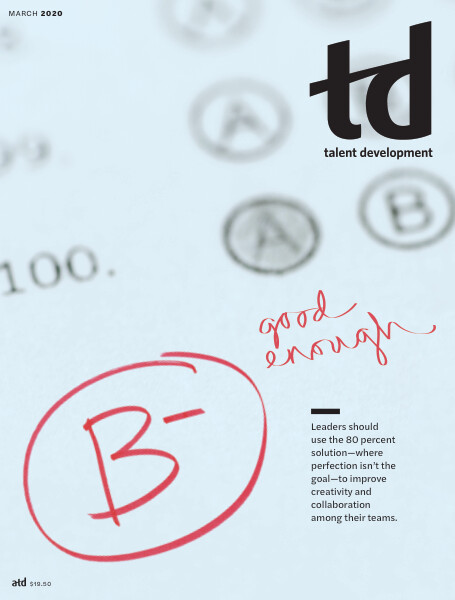TD Magazine Article
Primed for Change
Employees should learn to anticipate change, not retreat from it.
Mon Mar 02 2020

Bookmark
During my first presentation on change 30 years ago, I said, "Change is a way of life; it's a competency. It's not about your personality or whether or not you're good at change. You have to get good at it, be nimble, pivot quickly, and be ready for what's next."
Everyone resoundingly said, "Yes, we need to focus on change."
But we didn't. And three decades later, workplaces everywhere still struggle with change.
In fact, change is so constant and dominant that I now hear from people who say their companies cannot keep up with the pace of change, and their employees seem to be suffering. A 2019 Center for Creative Leadership study found that change fatigue is one of the top two challenges leaders face, and other surveys have found that change initiatives flounder because companies lack the skills to sustain change over time.
Why is change so painful?
I have a background as a family and couples therapist, so people commonly came to me in some kind of pain or suffering. In response, I would routinely start by checking three areas:
Are you using an outdated skill set on a new requirement? For example, with couples, perhaps one of them needs to improve their listening skills. In a work situation, an employee may need to learn a new software or keep up with continuing education.
Have you modernized your approach recently? In other words, are you trying the same thing over and over with no results?
What's your level of willingness? Are you willing to step up and make changes, or are you in constant resistance?
What I repeatedly found was that people's circumstances weren't the cause of their pain. It was more about flawed thinking—believing stressful thoughts not based in reality or not being willing to make changes. In such situations, suffering is optional and usually self-imposed.
Change myths and realities
In my time as a leader, I started to notice some concerning themes as I attended change management training throughout the years. Instead of focusing on how to get teams ready for what's next, the facilitator taught us to bend reality; slow things down; roll the change out slowly; sympathize by saying, "Change is hard;" and do the heavy lifting for teams so the change would be easier. That sounded a lot like coddling and enabling to me. I wondered: Where is the shared accountability for the individual contributor to get good at change?
That way of leading generated an enormous amount of emotional waste (in other words, drama). Coddling people through change led them to pine for the past, stay deep in resistance, hold onto personal preferences over business potential, and demand that leaders bend reality to keep their worlds from changing. Debunking some common change myths helps you and your team move beyond resistance and into readiness for change.
Myth 1: Change is hard. Change should be equally hard for everyone, right? But it isn't.
I conducted a readiness assessment with a company that was moving to an open environment, and my team measured factors such as tech savviness, how good employees did with the communication tools their organization provided, how up-to-date they were with technologies and new software, and how often they made self-initiated changes.
Then we labeled the employees on their level of readiness (high, medium, or low). Three months after the change, we measured them again, asking about how difficult or easy the change was. What we found was that there was a direct high correlation between an individual's readiness score and the difficulty of the change. Those who had low readiness scores thought the change was extremely difficult, and those who had high readiness scores said the change was a non-issue.
That is when I began to question the belief that change is equally hard for everyone. The reality is that change is only hard for the unready. And readiness is the key metric that determines how hard change is for an individual.
Myth 2: People need time to grieve. When I hear people at work moaning about needing time to grieve a change, I immediately think, "Which beloved family member or pet did they lose?" In those cases, mourning would make total sense. But for a software upgrade, not so much.
The truth is that most of the change people experience at work is about everyday improvements they need to make to adapt to a shifting marketplace or work environment. This requires maintaining a state of readiness to stay relevant and competitive, not grief counseling.
Employees who are in a state of high readiness don't require time to grieve. They are aware, willing, and advocates, and they are all in. They get fluent with new software or processes but not attached. These people are busy planning for what's next and ensuring a successful outcome.
Myth 3: There is too much change. Whenever I hear someone say, "There is just too much change" or "We are change fatigued," I know the person's ego is at play.
Just for fun, let's swap the word change with next. How ridiculous does it sound to say, "There is too much next," "Can we slow next down?" or "I can't handle all this next"?
When you start to change words for other words, you begin to see where egos are at play, where people have adopted some irrational beliefs and mental processes that aren't working for them.
The marketplace will always be charging ahead, whether employees like it or not—it's indifferent to whether people are uncomfortable. Instead of asking, "How can we make this change easier for you?" leaders should be asking, "How can we build your skills to make you better at change?"
Myth 4: Individuals can control the pace of change. Businesses don't have the luxury of slowing down change because their employees prefer it. When people continually resist change, they see it as something that is being done to them; they see themselves as victims.
If companies want to stay competitive, they must stop worrying about whether their employees are comfortable with the pace of change and instead drive their employees' development in a way that gives the organizations the ability they need to make change work for the business.
How to develop ready, willing, and able employees
Workers must get out of chronic shock syndrome around every change that comes their way, and leaders must get real about how they are enabling poor behavior on their teams. So, what can leaders do to cultivate readiness on their teams?
You can't please everyone. In times of change, leaders may be tempted to focus on making change least disruptive to the people. In reality, leaders need to work to make change least disruptive to the business. In doing that, stop trying to please everyone through change. Your actions can't please high- and low-accountable employees at the same time. You are always going to be upsetting someone—just make sure it's the right person.
Work with the willing. Leaders have been taught to essentially reward people in resistance by putting all their time, attention, and energy toward those employees. Would you be surprised to know that, on average, a leader will spend 80 extra hours a year thinking about and working with a single person who's in a state of chronic resistance? Leaders are sending the wrong message to their employees when they cater to and spend their time and energy on those in resistance. Instead, focus your time and energy on the willing.
Think inside the box. When leaders encourage their teams to think outside the box, what they get from employees are ideas on how reality should change and what everyone else should do to make that happen. Instead, encourage your employees to think inside the box, to focus their energy on how we could given our current circumstances and constraints, not why we can't.
Insist on shared accountability. Instead of leading your employees through change (zero accountability on the individual), cultivate a mindset of being ready for whatever is coming next. Develop an attitude of willingness—say yes, and use your expertise to move the change forward instead of using your opinions to slow it down.
Play favorites. I'm not advocating for playing favorites based on all the wrong reasons, such as race, religion, gender, or anything else illegal or immoral. However, I am in favor of playing favorites with individuals who are good at jumping in and saying yes, aligning with the organizational goals, forgoing their preference in favor of the business potential, keeping themselves ready for what's next, and being personally accountable for their results.
No more excuses
Over the years, leaders have allowed people to use the excuse that they aren't good at change or are suffering from change fatigue to resist new thinking and different ways of doing business. It's time leaders change their own thinking on this matter.
You must insist on—and equip your employees with—the skills and capabilities they need to be resilient and adapt. An individual's ability to handle change and be ready for what's next is one of the most important competencies you can cultivate on your team and the biggest predictor of your company's success.

More from ATD

